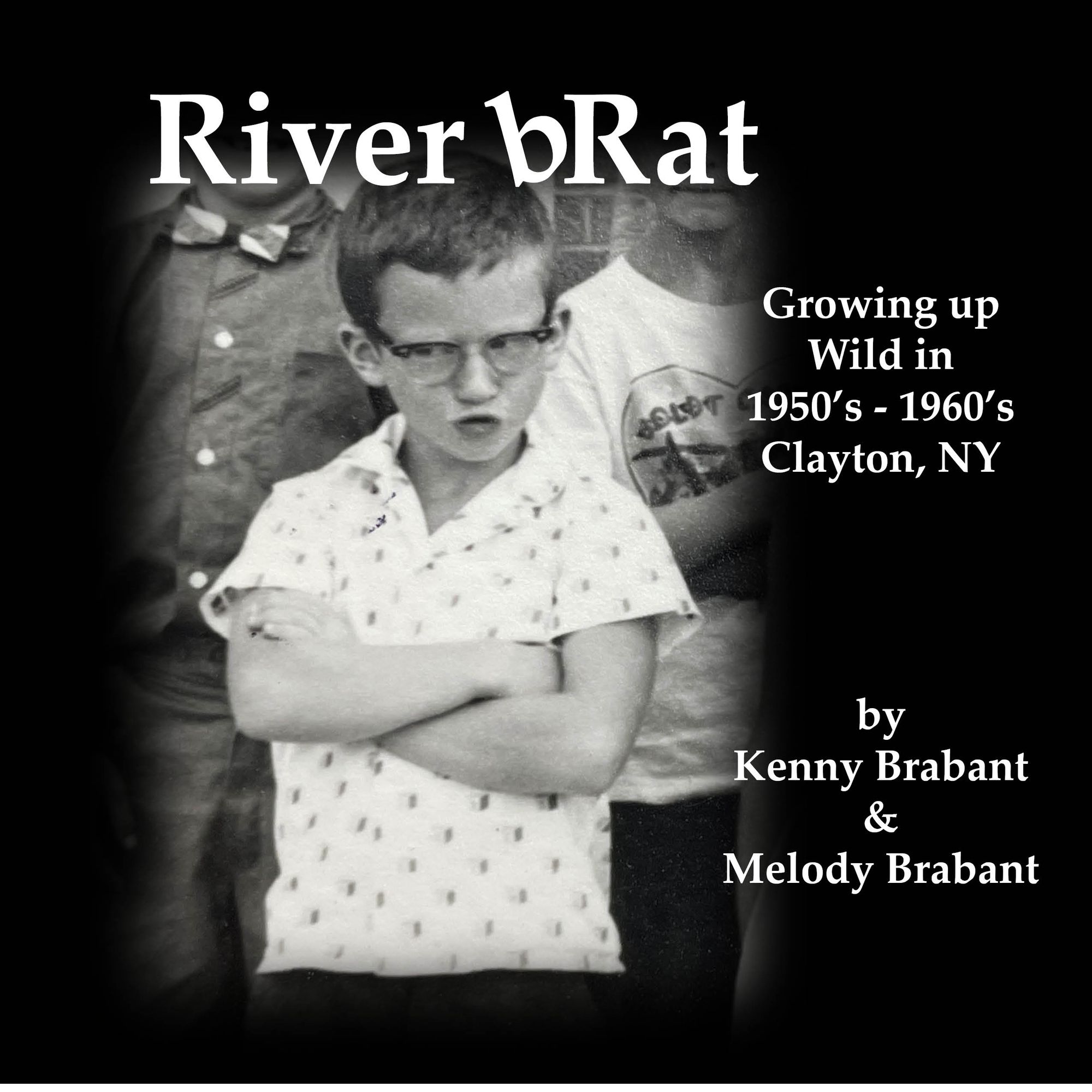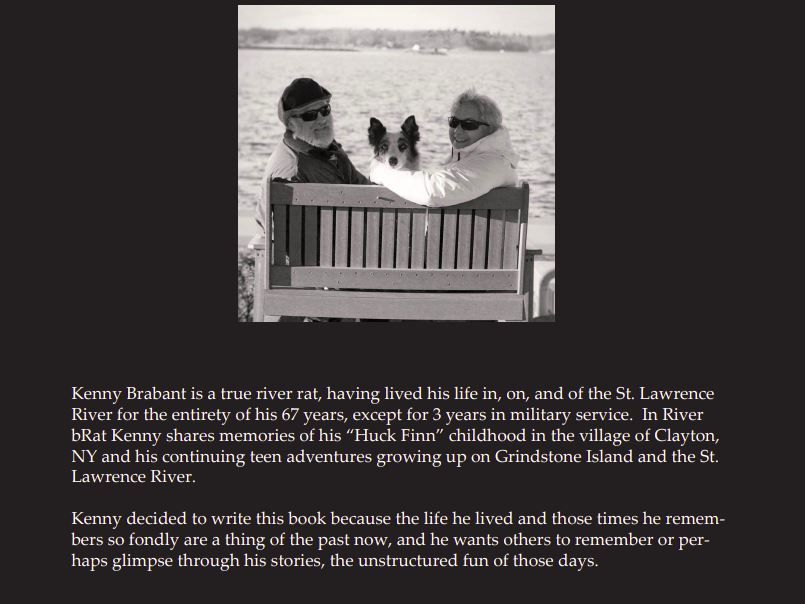The cover photo says it all! Where else would you find a book with the title River Brat and not wonder exactly who it was about? However, if you come from Clayton, NY, and you grew up in the 50s or 60s, you would smile and nod your head in agreement – just look at that young man! The book’s back cover introduces the River bRat Ken Brabant.


Ken Brabant and his wife Melody Brabant are not just River Rats! These two have been honored many times in their little town. In 2009, they received the Chamber of Commerce Citizen of the Year award – and in 2017 the Snowmobile Club presented Ken Brabant with a life membership in their club, as well as in the New York State Snowmobile Association (NYSSA). "This recognition was to acknowledge his efforts and achievements surrounding Lions Park in Clayton. Ken is the creator of the pirate ship at Lions Park and personally maintains all aspects of the ship. He raised the funds to purchase the ship and inspects and ensures that everything is in “ship shape” for the children that climb and slide all over . . . " These are just two of the many honors bestowed on the Brabants.
What about the book?
The layout is simple, and rather than having long chapters with lots of text, the book is divided into nine categories from Family-to-Family dynamics, or Kids stuff, School Days and Teen Years. A whole section is devoted to Pananen Farm on Grindstone Island, and of course, Grindstone cars, cars, and more cars. The final chapter starts with “The Girl I am going to Marry.”
I spent far too much time trying to decide which excerpts to include in this review. First it was the section starting on Pg. 23 and French Town, then three pages later it was page 28 and Swimming and the Municipal, and then it was page 94 with Delinquency – do not Try this at Home. Obviously, the stories are short, fun, and oh, so familiar. I grew up in the 50s and 60s too. Even though I’m sure that I was a goody, goody, my pals got into the same sort of mischief downriver near Montreal!
Now, all Thousand Islands books have a place on my bookshelf, but this one is being placed there with joy and regret. Joy, as I truly loved it and regret, as so many Islanders and mainlanders who are no longer with us are not able to see these stories in print.
Ken and Melody call those times “unstructured fun” and it was. Perhaps today’s youth could benefit from one less soccer match, one less dance class, or better still – one less hour of screen time!
Excerpts

715 Mary Street
After my dad died, we lived for years in an old rundown apartment house at 715 Mary Street where the Antique Boat Museum’s “Need for Speed” building now stands. The house was 135 years old when I lived in it. It had hand-hewn beams and in its earlier life had been a church and an opera hall. It was originally up on James Street where St. Mary’s Parish Hall is now (St. Mary’s School before that). It was later moved to Mary Street and converted into four apartments.
My mother paid $30 a month rent. I vividly remember that on windy winter days the air would blow in through the cellar of that building, up through the wooden floor slats, and flap the carpet in a corner of our living room. With four young families living in this apartment house, there were always lots of kids around and something fun happening. We walked together to school, went to the movies, hiked, had apple fights, and more serious battles too.
It was during these years that I became known alternately as Carrot Top and Fire Dome. My flaming red hair came from my Great Grandma Putnam. I wore big, black rimmed glasses which were standard issue for all boys with glasses at that time. I lost the first pair shortly after getting them, and happily, by about age 14 I outgrew the need for glasses all together.
Our apartment house gang (there were many similarities to the “Our Gang” television show we watched) would head out of town to play sometimes. One memory from late summer was going out to the Zenda Farm fields and rolling over hay bales to whack the mice that were underneath. One time we dropped a couple of live mice into my friend Keith’s boots, and one bit him on the toe.
And we explored that old apartment house from attic to basement, finding great hiding spots for hide and seek or quiet places when we needed to be alone. I could recognize whose door was closing from the sound of the dustpan hanging on the back, or the loudness of the slam as it closed, and which screen door was squeaking, even which adult was coming or going by the sound of their footsteps. I learned a lot about family dynamics, and who it was safe to lend money to, adult and kid alike.
The adults would help each other out with childcare and often shared babysitters so they could go on outings or have meals together. I remember thinking after eating with some of these other families, how different mealtimes could be – the food, the formality, the rules. Some were multi-generational families too, with grandparents living with them. It was a lively place, a mini-community, and the sounds of life in that building have not faded from memory.

Tour Boats
American Boat Line tours left out of downtown Clayton all summer long in the 50’s and 60’s. They were located on Riverside Drive, just west of the intersection with James Street. There was a ticket office and souvenir shop leading to a big open but covered walk-through area for passenger loading. In the middle of this open area there were two big horse troughs with mesh metal covers. The boy scouts, Pack 32 or 46, would go fishing and fill the tanks, then hang a big sign above asking for coins to be tossed into the tanks to support their activities. Visitors loved looking at the fish, and there were always lots of fish and coins in the tanks.
There were boat line hawkers that worked out at the street, flagging people in to take the tours. I remember Charlie Rexford and Jeremiah Black specifically; they were good at it. Mr. Black was a schoolteacher, but he acted like this made a good and entertaining summer job. Charlie lives in Alex Bay now and promotes unity in the three river communities of Cape Vincent, Clayton, and Alexandria Bay. We keep in touch, with a phone call or visit from time to time.
If they weren’t full up, the tour boat captains would let us kids ride for free with a note from our mother. One summer I kept track, and I rode 38 times. My brother Fred was a deckhand and one day a passenger stopped him and asked about his shoes. Fred told him they were Sperry Topsiders, and great for boat decks. It turned out the man was the owner of Sperry Shoes, and he sent Fred a supply of those deck shoes.

The early tour boats were wooden, the Miss Clayton I and II, and the Adonis, which was an old navy double-decker surplus boat with 3 engines. They were just starting to change over from wood to aluminum when I was a kid. The aluminum boats, the Neptune and Venus, were far less maintenance, but the old wooden boats were much quieter and nicer to ride in.
Generally, the captain or a deck hand would also be an announcer. Along with the more factual information shared about the river and islands, there’d be some tall tales. It was fun to see just how many passengers would hurry to look over the port rail when it was announced that the white border line between Canada and the US could be seen there, on the bottom of the river. And there would be murmurs when they were told one summer home had seven kitchens - followed by groans when the announcer continued “Mr. Kitchen, Mrs. Kitchen, and 5 little Kitchens.” One other “fact” shared, was that the river was self-cleaning; that every 7 miles, because of the granite shores, the river cleaned itself.
If I wasn’t riding a tour boat, I’d most likely be jumping off the dock with friends into the wake just behind it as they headed out. Sometimes we’d holler to the captain, and he’d gun it for us to make a bigger wake to surf, until one day a deckhand didn’t undo a line in time and that extra engine power yanked out an entire section of dock.
More About the Neighborhood, Pg. 37
There was a phone booth on the comer across Uh-street from my house, between Breitenbeck's and the municipal dock. It was visible out my living room window which gave me a perfect spy location. My friends and I would watch people walking toward that corner and call the phone booth as they neared.
When they answered, we would comment on the outfit they were wearing, color of their clothes, etc., or just ask something like “what would you be doing if you hadn't answered the phone?"
Next to the phone booth was the light control for municipal dock lighting. Sometimes we would sneak over and unscrew the electric eye to make the dock lights go out, then hide and listen to the conversations as the overnight dockers came together wondering what could have happened. If it looked like they were on to us, we would run like hell to not get caught. The next day, DPW ( Dept. of Public Works) would come and screw the control eye back in. We could also kick the telephone* poles that had lights on them, and the lights would go out for 15 minutes. We went down the street doing this until the entire block was dark. This lighting was changed when I was a kid, and what sticks in my mind other than the fun discovery of being able to kick them out and unscrew the electric eye, was that the light itself was different - you couldn't see the snow fluttering down nearly as well with the new bulbs.
River Brat: Growing up wild in 1950’s – 1960’s Clayton, NY. By Kenny Brabant and Melody Brabant is available in Clayton at Reinman’s Dept. Store, The Little Book Store, The Antique Boat Museum, and Hunner’s Market; or direct from the Brabants.
NOTE: There will be a Book Signing for River Brat: Growing up wild in 1950’s – 1960’s Clayton, NY . on August 22, 2-4 pm. at The Little Book Store, 413 Riverside Dr. Clayton, New York 13624
Book Review by Susan W. Smith, editor, info@thouandislandslife.com
Posted in: Volume 16, Issue 8, August 2021, Book review
Please click here if you are unable to post your comment.
